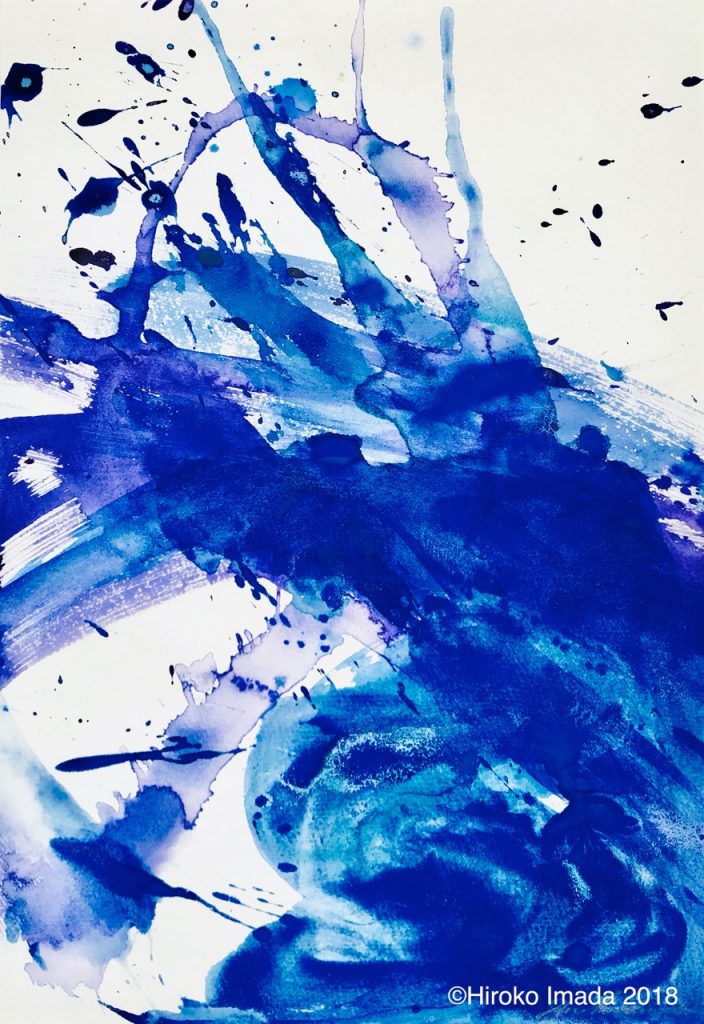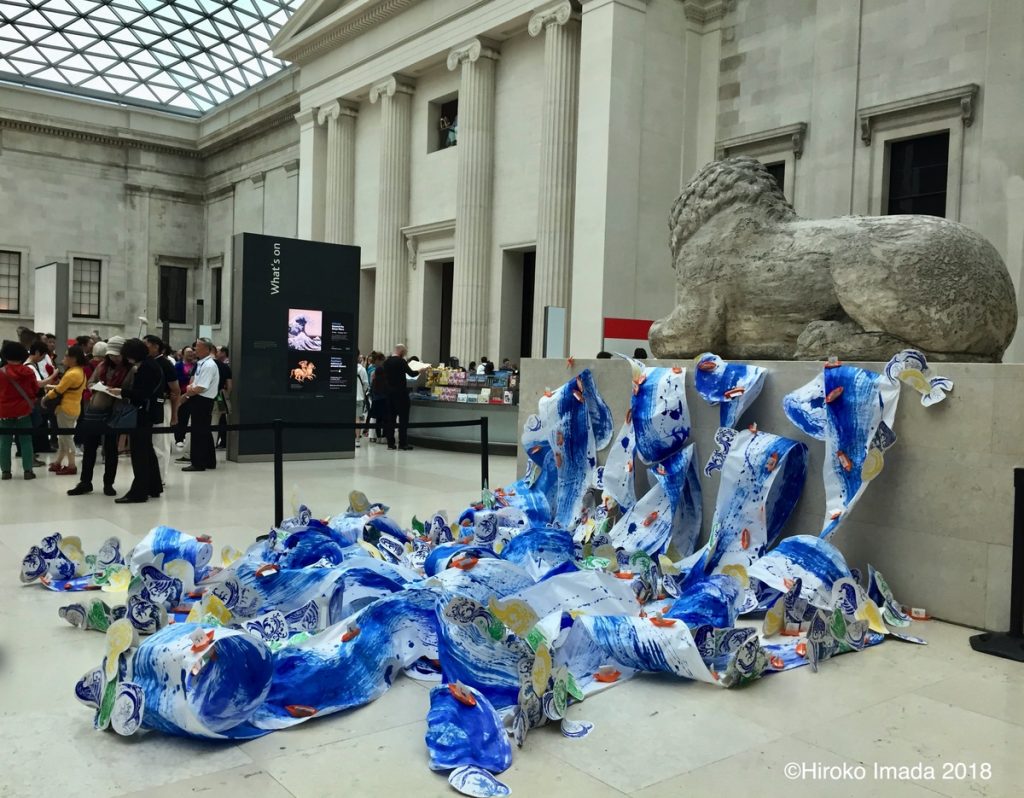 Flow Ⅱ
Flow Ⅱ Flow Ⅲ
Flow Ⅲ
Your art career has spanned over 30 years. Could you share how you first became interested in art?
HIROKO IMADA: It is hard to say when I first became interested in art but I can say it must have been the influence of my mother, who loves art in general. I remember I used to go to art exhibitions, museums, classical concerts, theatre, etc. with my mother from when I was a small child, and I really enjoyed the experience. Also, I started to have piano and violin lessons at an early age and later on I was a member of a chorus from the ages of 8 to 12, and I took part in a group art lesson from the age of 4. It was very natural to me to be surrounded by any form of art from when I was a little. Funnily enough, I loved music a lot but didn’t enjoy practicing and eventually stopped all music lessons at the age of 12. However, with art lessons, it was always on and off when I was at primary school as I enjoyed playing with friends outside more at that time, but I carried on with it loosely and eventually became a professional.
At first glance your work feels very contemporary, but it draws on traditional Japanese art and craftsmanship, such as woodblock prints, folding screens and hanging scrolls. Could you also tell us a little more about how you developed your style?
HI: In my time in Japan, in order to pass the entrance exams at the art universities we needed to be trained to be able to produce good observational drawings and paintings, and by the time I got to the art university I felt I had had enough of it and wanted to do something different, so I started to experiment, creating my works in an abstract way by using mixed media. My university had a very unique module, introducing a number of different printmaking techniques in our first year, and I really got into it. I feel I was very lucky to have two very good tutors at my university, who I still keep in touch with; Mr. Harumi Sonoyama is my lithography tutor and Mr. Handoku Ito is my woodblock printing tutor. They were both very supportive and encouraged me to do some experimental works, so I started to create paper installations with my own handmade paper that I had painted or printed images on to. This was the starting point for my installation work.
As I became more interested in printmaking in general, I also became interested in papermaking and paper itself, so I started researching Japanese paper and papermaking. I visited many paper mills in Japan in my second and third years at university. I was absolutely fascinated by the beauty of Japanese paper and its process, so I started to make my own handmade paper. After coming to London my admiration for traditional Japanese craftmanship increased, and later in 2000, with grants from Daiwa Anglo-Japanese Foundation and The Great Britain Sasakawa Foundation, I intensively studied Japanese folded screen making and hanging scroll making through one-on-one tutorials with Mr. Naoki Miyasaka in Japan, with help from Masumi (a mounting material shop).
I utterly respect Japanese craftsmen and craftmanship because of having learnt these skills myself, knowing how difficult it is to reach a certain level and being aware that my ability will never reach that of those who practice and focus on a specific discipline every day. However, as an artist, I can take on these techniques and use them in my works with my own twist. By presenting my art works with a hint of Japanese traditional art techniques I hope that they will attract not only people who are art lovers but also those who are interested in Japanese culture and crafts. I would like to introduce the traditional Japanese mounting techniques to this country as a new way of presenting art works.
In what ways has the COVID-19 pandemic affected how you and your peers work, or the way in which you create?
HI: I was lucky to have a studio at home so I had no problems with finding the space for creating my works and I am also used to working alone at home, so in terms of creating there has not been much difference. However, a number of events were cancelled, postponed or rescheduled, as has been the case with many other artists. I tried not to think about that too much since they will be mounted again one day (I hope!) and instead I decided to use this time as an opportunity to get things done for which it would otherwise be difficult to find the time. I managed to tidy up my studio, sort out materials and my old documents, digitalised my old slides and photos; things that were waiting to be done for a long time. So, this was a positive improvement in things for me during the pandemic. I have been trying to make sure that my daily life and creative space are not affected too much by the pandemic.
How do you think we can better support artists and creatives, many of whom are freelancers, during this time?
HI: It is a very difficult and challenging time for the arts as the resources for support are limited. But I especially hope those who are at the beginning of their artistic careers will get some support, so that they are given a chance and able to continue their work.
The art world is constantly evolving, but the pandemic has changed the landscape of exhibitions for the foreseeable future. What do you hope for the future of exhibitions, or museums and galleries more generally?
HI: I desperately hope the pandemic will be over soon and we can go back to the life we had before. During the pandemic lots of online materials were developed and I do admit there are lots of really good ones and I used them too, but they cannot equal the actual experience in a location and it will never be the same. We all miss the human touch and even the recovery process is slow due to the cautiousness required in bringing back the interactive, human-to-human element which is so precious and enriches you emotionally.
Having exhibited in both Europe and Japan, are there any cultural nuances that influence how you curate shows based on the local audience?
HI: I do not particularly have the local audience in mind when I prepare works for a show. But when I discuss the exhibition related events with the organiser, I consider who the audience is, and also where it is going to take place. The workshops always need to be adjusted depending on who I run them for and their background, age, education, etc.
Similarly, you have studied art in both Japan and the UK. Have you noticed any differences or similarities in how art education is viewed or approached?
HI: In art education in Japan, we learn about an extensive range of subjects and techniques in a four-year BA course at the university and one is very busy following them all. It is more like tutor-led studying. It was good to have to push your knowledge and skills to reach a reasonable level so as to become independent in a short amount of time. Here in the UK I did a postgraduate two-year course at the Slade and during that time I was constantly questioned by my tutors, who asked me why I was creating this, why I was using these materials, why this colour etc. If you have a solid base already it is really good experience to deepen your understanding of yourself and your art in preparation for becoming a professional. However, you have to speak out about what you want and what you need because if you do not express that yourself, nothing will happen.
You specialise in teaching art and even established the Japanese woodblock printing course at the British Museum over twenty years ago. Do you have advice for anyone inspired to start painting or printmaking during lockdown?
HI: It isn’t easy to start new technical things when you cannot be taught in person but there are lots of good online materials that can be of help. So, if you feel like doing it, go for it. Then, once the world goes back to normal, you can always learn and get more help in person. During the pandemic, I have done lots of research into Japanese woodblock printing and its materials and it is still an ongoing project. I am hoping the results will be reflected in my teaching when I am back at the British Museum and the Prince’s Foundation School of Traditional Arts.
‘Shapes of Water’, your 2018 show at Sway Gallery London, was inspired by Hokusai’s iconic ‘The Great Wave off Kanagawa’, and it also explored the symbiotic relationship between music and art. How did this multidisciplinary collaboration come about?
HI: ‘Shapes of Water’ wasn’t the first time I worked with a musician. Back in 1992 at my degree show at the Slade, I worked with the Korean composer Shinuh Lee, now a professor of composition at Seoul National University, and in 1995 with Warwick Thompson, who is now a music critic. Then I worked with Nicholas Sabisky, a composer/ flautist, in 2015 in Finland and 2018 at Sway Gallery London. I am hoping to bring him back again as part of my solo exhibition at Sway Gallery this autumn, November 2021. Because of the influence of my early music education it is not strange to me to be inspired by music, to create something with it, to interact with it. It is always a joy to work with talented musicians and composers. We are expressing the same thing in a different format and when it comes together, the excitement of it is so much more than when you are creating something on your own.
My ultimate aim is to collaborate with musicians/composers and dancers/choreographers to create a piece of art work. I am very much looking forward to coming back to Sway Gallery to present my new works. The exhibition will be a continuation of the work in the 2018 exhibition and the interactive installation work at Coventry Cathedral, which is due to be installed in July 2021. What sort of events we can run at the time in November is still a question but I will try to do something within the terms of what is allowed.
Both Hokusai’s name and work is synonymous with Japanese art. As a final note, do you have any recommendations for those looking to find out more about little-known Japanese culture?
HI: In terms of Japanese artists, I like Hokusai, Itō Jakuchū, and Hasegawa Tōhaku. I like their bold compositions and beautiful lines – the stillness and motion. My favourite books are The Tale of Genji by Murasaki Shikibu and Spring Snow (The Sea of Fertility 1) by Yukio Mishima. I think both books have been well translated into English without losing the beauty and sense of the Japanese. Both depict scenery really well and you can visualise things as if you have actually seen them. If you see these art works or read these books, you may see their influence on my art.
